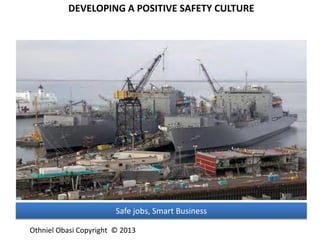
DEVELOPINGA POSITIVE SAFETY CULTURE
- 1. DEVELOPING A POSITIVE SAFETY CULTURE Safe jobs, Smart Business Othniel Obasi Copyright © 2013
- 2. Occupational Safety and Health Act of 1974 • To secure the health, safety and welfare of persons at work • To protect other people from hazards arising from work • To control the keeping and use of dangerous substances and materials, including explosives and highly flammable materials.
- 3. Benefits for Establishing Positive Safety Cultures • Reduces extent and severity of work related injuries, illnesses and property damages • Improves productivity and employee morale • Reduces insurance premiums
- 4. Basic Elements The following basic elements are essential for an effective Ports safety and health program : • Management Commitment and Leadership • Employee Participation • Hazard Identification, Assessment and Control • Accident and Incident Investigation • Training • Program Evaluation • Recordkeeping
- 5. Management Commitment • Establish health and safety policy and culture. • Define the responsibilities of supervisory and non supervisory employees for managing safety and health in workplace. • Provide appropriate authority and adequate resources to develop and carry out the program
- 6. Workers Participation •Survey or interview •Safety stewards •Safety meetings, •Employee suggestion system. •Safety Committee
- 7. Hazard Identification • Hazard Categories • Chemical e.g. Hazardous substances • Biological e.g. bacteria • Physical e.g. noise, vibrations • Ergonomic • Psychological e.g. Occupational stress.
- 8. ERGONOMIC • This is the science of fitting the job to the worker the tool the workstation the task (job content & context) the organization the environment
- 9. ERGONOMIC • Goal –to reduce work-related musculoskeletal disorders (MSDs) developed by workers • MSDs are injuries and illnesses that affect muscles, nerves, tendons, ligaments, joints or spinal discs.
- 10. ERGONOMICS • Painful joints • Pain, tingling, numbness in hands, wrists, forearms, shoulders, knees and feet • Shooting or stubbing pains • Swelling or inflammation Common Symptoms of MSDs
- 11. ERGONOMICS • Fingers or toes turning white • Back or neck pain • Stiffness Common Symptoms of MSDs
- 12. Risk Factor: ERGONOMICS Static posture
- 13. Risk Factor: ERGONOMICS Forceful exertion
- 14. Risk Factor: ERGONOMICS Repetitive movement
- 15. STRESS
- 16. • The harmful physical and emotional responses that occurs when the requirements of the job do not match the capabilities, resources or needs of the worker.
- 17. STRESS: Effects
- 18. STRESS PSYCHOLOGICAL Fatigue Anxiety Tension Irritability Depression Boredom Inability to concentrate Low esteem PHYSIOLOGICAL Heart rate Blood pressure Indigestion BEHAVIORAL Drug use Alcohol intake Heavy smoking Impulsive emotional behavior Poor work & family relationship Social isolation Family abandonment Sleep problems Manifestations of Stress
- 19. RISK Rating
- 20. HAZARD CONTROL
- 21. Accident and Incident Investigation • The employer should promptly investigate workplace fatalities, injuries, illnesses, and potentially hazardous incidents (“near misses”). • The Hazard Assessment and Control component of the SHP is primarily a proactive measure; that is, aggressive implementation of this element may mean that the employer is able to identify and control all workplace hazards before any employee has been injured or becomes ill. • At the same time, employers should investigate incidents is injured, becomes ill, or narrowly escapes death or serious injury.
- 22. Training • The employer needs to ensure that each employee who may be exposed to a workplace hazard is provided with effective training. • In addition, the employer needs to ensure that all employees, both supervisory and nonsupervisory, who are responsible for the SHP are provided with training so that they are able to carry out their responsibilities.
- 23. PROGRAM EVALUATION • The employer needs to evaluate the SHP to ensure that it is effective in identifying and controlling serious hazards, and appropriate for workplace conditions. • Where significant deficiencies are found, the program should be corrected or updated in a timely manner.
- 24. Recordkeeping • The employer should maintain records in order to be able to demonstrate the effectiveness of the SHP. • Employers need to maintain enough records that will allow them to know what hazards need to be controlled and to evaluate the effectiveness of the SHP in reducing fatalities, injuries and illnesses.
- 25. Recordkeeping Examples of some records that employers typically maintain on workplace safety and health include: • First reports of injury; • OSHA 300 logs; • Safety and health committee reports; • Accident and “near miss” investigations
